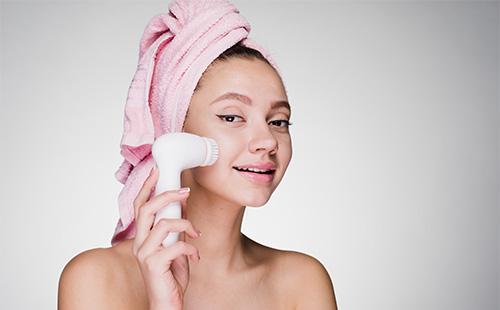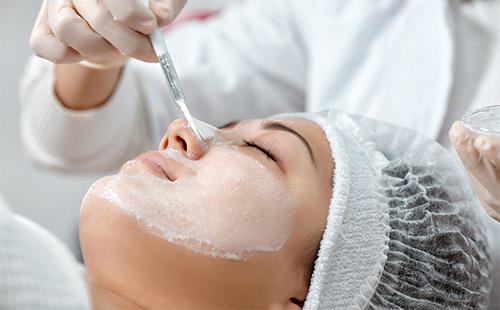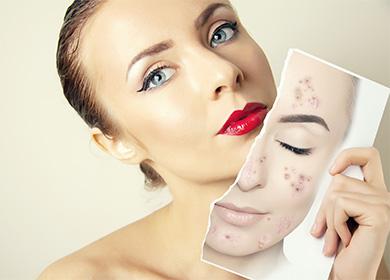The content of the article
The older the acne scars on the patient's face, the less likely they are to noticeably smooth them. Complete removal can be achieved only in isolated cases, and home remedies do not give such an effect. The type of pits from acne and pores stretched by comedones depends on the age of the patient himself. The older the person, the more noticeable marks leave new foci of inflammation on his skin. But by the age of 40, defects obtained before the age of 25 are smoothed even by half more than without assistance.
Types and causes of defects
The causes of systemic rashes in the form of black or white “dots” and inflammations beneath them are not completely clear to science. She managed to single out only a set of the most influential factors of their strengthening or weakening, control over which reduces the number of new rashes and their tendency to become inflamed. Among them are the following.
- Features of the diet. Addiction to everything fried, greasy (especially if the fat has an animal or mixed, like margarine and spread, origin), spicy, spicy, as well as a tendency to overeat.
- Digestive tract diseases. With them, digestion becomes unstable, loses much in quality, the absorption of the components received with food is disturbed. The skin no longer receives the substances it needs to regenerate, and by nature it is an organ that must be constantly updated.
- Skin and general infections. Demodecosis, skin fungus, herpes. Pathogens inhibit the functioning of the body's entire immune defense.
- Endocrine pathology. Especially diabetes mellitus, in which the capillary blood supply to the skin is disturbed due to damage to the collagen layer in the walls of blood vessels by sugar crystals.
- Hereditary predisposition. Sometimes associated with the features of the endocrine glands. These hormonal imbalances transmitted from generation to generation are more often manifested as a tendency to acne. Or “programmed” in the form of a special structure of the skin itself: well-developed, deep-sebaceous glands, their channels are too narrow or irregular in shape.
- Hormonal disorders. Inherited or acquired. They can be achieved by taking steroid drugs, get "on load" to the pathology of one of the endocrine glands. For the female body, cyclical changes in the background generally form the basis of the ability to reproduce.
- Inadequate hygiene. Including situations when the patient does not use detergents for the face, but constantly updates the layers of cream on it.
- Autoimmune process. It arises from frequent exposure to the skin of strong irritants in the form of scrubs, bleaches (soda, organic acids), salts, ultraviolet light.
- Taking medication. Barbiturates and a number of other drugs, including corticosteroids, can cause skin rashes as one of their side effects.
- The specifics of the work or living environment. In the form of frequent contacts with chemically active substances (lithium, chlorine, bromine and their compounds).
Among the most common defects that remain on the skin after acne, there are red spots (residual blood stasis that quickly disappears in youth and tends to “linger” for several months in adulthood) and atrophic scars - “craters” of various widths and depths, often surrounded white spots or “rollers” - scar tissue. With age, dark spots may also appear on acne sites - areas with altered pigmentation. Usually they are not formed immediately, but some time after the final solidification of the defect boundaries.
Professional treatment
How to treat this kind of problem? Currently, it is easy to cure, since the range of pharmacy ointments, creams and gels for eliminating post-acne is even wider than the assortment of colds. You can read the reviews on the site. They really help get rid of the most pliable part of such traces - spots of varying degrees of redness. As for irregularities, here they are almost powerless - they require the use of long courses (from six months or longer), with modest results. To solve such problems, modern cosmetology is better suited, which has learned to very effectively align the color and texture of the skin and restore its elasticity. But she has several major flaws.
- High price. Usually we are talking about the work of high-tech equipment and the use of expensive imported drugs, materials, programs. Grinding facial scars using methods of hardware cosmetology is not available to the vast majority of patients with acne and does not allow to resort to repeated and supportive treatment as often as necessary in each case.
- A large number of errors. Their percentage is affected not only by the often low quality of education of the future doctor. Even the well-trained specialists lack a truly extensive, full-fledged practice due to the high prices and low availability of their services.
- Ignoring Delayed Consequences. Cosmetology is a field of medicine designed to combat traces of aging and skin diseases, with the understanding that the result achieved is still not eternal. Therefore, it is more likely than other industries to make effective “here and now” decisions even if after a few months or years they lead to new defects, accelerated withering of the skin, and malignant processes in it.
- Large-scale and powerful impact. The radicalness of chemical and laser peels from acne scars differs from gold reinforcement or skin tightening not as much as we would like. The only difference is that in the first case, the patient is cut off the topmost layer of the epidermis from the entire face, and in the second, pieces of skin are removed in separate areas. Not every skin has the necessary resource for regeneration in a given direction. And this only increases the likelihood of unexpected reactions on her part, especially at the age of 30 years.
Currently, the most widely applied treatment is post-acne laser - a proven practice for high accuracy and a universal means of solving many dermatological problems, starting withrosacea and ending with cellulite. The following options are no less popular.
Chemical peeling
It requires the participation of weak and strong acids like malic, trichloroacetic, and phenol.A modification of the peeling that is well suited for home use is a scrub based on the same acids or solid particles like apricot kernel powder.
Mesotherapy
Perceived by most patients as “safer injections of beauty” for skin. The essence of mesotherapy is to introduce elastic proteins (collagen and elastin), hyaluronic acid (indispensable for the formation and normal functioning of intercellular structures that combine them into tissue) into the deep layers of the skin, vitamins and other components it needs. The procedure consists of a series of multiple microinjections with thin needles, and in fact it is quite traumatic. The effect occurs after a few days or a week, and lasts for several months.
The "domesticated" version of mesotherapy can be carried out using a mesoscooter - a needle roller that is convenient in use. In this “execution”, the active substance intended for administration under the skin must be applied with a sufficient and continuous layer on its surface, and then repeatedly “rolled” this area with a roller, pressing lightly on it. It is difficult to remove acne scars only this way - to start smoothing them you need at least a dozen procedures for six months or more. But with a successful selection of drugs, a good skin response to them and the absence of excessive injuries, the procedure helps to improve blood circulation to the skin, increase its elasticity and speed of recovery.
With performance far from ideal, acceleration of aging is likely with the appearance of new wrinkles, areas of sagging, pigmentation and resorption of subcutaneous tissue. Mesotherapy is strictly contraindicated in the presence of "fresh" acne, malignant tumors, a rash of unclear etiology, other epidermal injuries (scratches, scratches, recent peeling) in the area of exposure.

Plasmolifting
He is the oldest, but has undergone a serious "modernization" way to remove acne marks and say goodbye to their relapses. Plasma lifting was the "successor" of autohemotherapy, which was widely practiced in the treatment of acne in the USSR. It consisted in the selection from a vein and the subsequent introduction of the patient’s own blood into the upper lobes of the buttocks. And plasmolifting involves first the isolation of the sick plasma from the blood of the patient, screening of its shaped bodies with the preservation of plasma proteins, including coagulation and immune, and then its introduction by mesotherapy (a series of microinjections) into the skin of the face.
If the principle of mesotherapy with various nutrients is still clear, then no one can explain how plasmolifting and autohemotrapy work. It is assumed that they stimulate local or general immune reactions due to the targeted administration of immune proteins, which helps to eliminate rashes and accelerate skin regeneration.
Ways to get rid of post-acne at home
Ways to get rid of spots from acne is not limited to only scientifically approved or healers. There are many intermediate options - designed for other purposes, and that have received new application as they study their properties in practice. Of these, the following.
- Silicone patch. Designed to be worn under clothing, on large and gross traumatic, postoperative scars. Silicone plasters soften them, protect them from rubbing on clothes and drying them in contact with air, which reduces their growth rate.Wearing such a “decoration” on your face is no easier than the defect he is hiding: the scar patches are flesh-colored, but this does not affect their visibility. The patch ends immediately after removal.
- Hydrogen peroxide. A light antiseptic used in medicine exclusively externally to disinfect epidermal lesions. Science does not approve of the use of peroxide inside to saturate tissues with “atomic” oxygen, its burning of papillomas, warts, scars and age spots. The lack of scientific approval does not prevent its use for such purposes, since most often there are results, and it does not matter how many of them are explained by the placebo effect.
A similar situation is observed with essential oils, juice aloe or table vinegar. The first of these rich, capable of literally burning the skin, extracts began to apply traditional medicine. Then science confirmed that essential oils:
- act as light antiseptics;
- stimulate local and general blood circulation;
- relieve nervous tension;
- eliminate the reactions of the cardiovascular system (migraine, mild arrhythmia).
The whitening properties of vinegar are also known for a long time and widely - like any edible acid. But dermatologists strongly recommend using acids to whiten the skin in its pure form instead of complex mixtures: they are all strong allergens.
The benefits of extracts of “skin” herbs like a golden mustache, plantain, celandine are also undeniable. Folk remedies for scars and scars on the face usually help to control the scale of new rashes and eliminate residual inflammation in place of the old ones. But “potholes” and wide “craters” they cannot even out. Most often, from folk remedies for the treatment of post-acne, the following are recommended.
Lemon juice
In lemon, there is a concentrate of ascorbic acid. Its ingestion is more useful than external applications. Like all acids, including benzoic, tartaric, malic andsalicylic, it has a whitening, disinfecting, exfoliating action.
Mummy
This is the result of centuries of "self-digestion" of wood from prehistoric trees, remains and waste products of animals and insects of the same period. This substance is considered a good adaptogen and dietary supplement. Official medicine clarifies that the diverse and not so usable composition of the mummy can simply stimulate the immune system, increasing its activity, and can also provoke an allergy. Applying a mummy from scars is a dubious step. It has no components that directly affect skin regeneration. But if you do this, it is better locally, by mixing a mummy slightly diluted with water with any cosmetic cream.
Essential oils
“Squeeze” with a strong aroma and such a high concentration of alkaloids and tannins that it is enough for a light burn. Rosemary oil is used to whiten acne spots, and tea tree relieves inflammation. Sea buckthorn oil - A good antiseptic with a drying effect on the foci in the acute stage, it helps new acne to open faster.
Among the oils that are beneficial to the skin are also often castor oils. In fact, it has its own specificity and is not ethereal. It is obtained from castor seeds, and from a chemical point of view, it is interesting in that it is 90% formed by derivatives of only one fatty acid - ricinoleic. Oleic, linoleic acid, which is more typical for vegetable oils, in the composition of castor oil, only the remaining 10% falls. Ricinoleic acid is unsuitable for consumption and irritates the walls of the digestive tract when swallowed. Hence the laxative properties of castor oil, which in industry has found wider application than in medicine. Attempts to use it to remove acne scars are associated with its emollient, water-repellent properties on the skin of which shoes, gloves and other haberdashery are made.With its help, small papillomas and warts are removed.
Castor oil is as irritating to the skin as it is to the intestines, and therefore it is part of Vishnevsky ointment, other mixtures with local “warming” action along with camphor, menthol.

Honey
Masks are used to treat acne marks with its addition, especially based on fermented milk products and fruits. Honey is considered a highly nutritious ingredient and is commonly used for dry skin. It is not suitable for oily, problematic and sensitive skin, because it contains simple carbohydrates of various types - a breeding ground for many pathogens, including yeast. But he really is an agent that allows the components of the mask to absorb faster and more fully. Therefore, its use is advisable only on the skin of a suitable type and in cases where the mask contains elements that are difficult to absorb - proteins, vitamins, trace elements.
Clay
The traditions of using multi-colored clays for skin treatment came to us from India, but they were also common in several countries of the Mediterranean. To remove “fresh” inflammations, comedones and pustules, black clay is usually used with the addition of sulfur - a disinfecting, drying, stimulating capillary blood component. White clay is most often used to treat post-acne spots - especially when mixed with Aspirin (acetylsalicylic acid) or badagi. She is a strong irritant, capable of also increasing redness.
It is believed that completely remove acne marks, even with the help of deep peeling, filling fillers is impossible. This opinion is true in relation to non-invasive and minimally invasive products that are most convenient for use at home - pharmacy and folk creams, masks, devices for independent mesotherapy, galvanization, wave, light therapy. And the results of clinical cosmetology depend not so much on the effectiveness of the method itself, but on the current regenerative resource of the skin.

